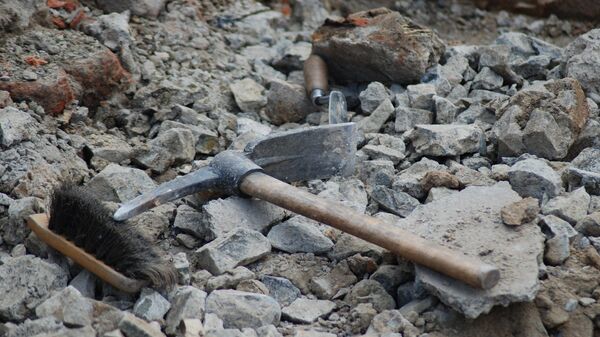Archaeologists have discovered what they believe to be the world's oldest cave art on the Indonesian island of Sulawesi.
The paintings depicting wild creatures and supernatural-looking human-animal hybrids were possibly painted at least 43,900 years ago, according to the team led by archaeologists Maxim Aubert and Adam Brumm, both from Griffith University in Gold Coast, Australia.
#Indonesia #archaeology / "A cave-wall depiction of a pig and buffalo hunt is the world’s oldest recorded story, claim archaeologists who discovered the work on the Indonesian island Sulawesi" / Ancient cave art discovered in Indonesia / https://t.co/Yd74GKlvuL
— Agnes E.M. Jonker (@MasdelaBarque) December 11, 2019
The mural was first discovered spread out across eight feet of flaking rock in a remote cave - Leang Bulu' Sipong 4, one of the many caves in Sulawesi's Maros-Pangkep region, in December 2017. However, it is only now that archaeologists have finally been able to prove how old it is.
The part-human, part-animal hunters shown in the ancient artwork could be a sign that people at the time believed in supernatural beings, according to the scientists' report, published in the journal Nature on 11 December.
"We assume these ancient artists were Homo sapiens and that spirituality and religious thinking were part of early human culture in Indonesia," Brumm said.
The cave art depicts two pigs and four miniature buffalo called anoas, with eight small figures seemingly hunting them, as they hold long, spindly objects pointed toward the animals that might be ropes or spears.
What’s peculiar is that these figures have both human and animal features.
According to Brumm and Aubert, one of the hybrid figures appears to have a tail, while another one is sporting a long snout or beak.
This could hint at early spirituality or shamanic beliefs.
“Maybe early people at that time saw themselves as an indivisible part of the animal world,” says Adam Brumm.
Aubert’s team claims that the figures might be the oldest human-animal hybrids ever found in a work of art.
Previously, a lion-headed male figurine carved from ivory in what’s now Germany 39,000 to 40,000 years ago held that title.
When dating the cave art, the team sampled deposits that grew over parts of the painting and discovered that the minerals started forming between 35,100 and 43,900 years ago.
The researchers are looking at these dates as minimums, since it’s possible that the mural was made even earlier.
In 2018 scientists discovered a vast gallery of cave art in Indonesia, on the island of Borneo, that portrayed cow-like creatures, dated back 40,000 years and was considered to be the oldest rock art to date.
World's Oldest-Known Figurative Paintings Discovered in Borneo Cave art https://t.co/Kermb1ONTC
— CF Yetmen (@CFYetmen) February 3, 2019
Globally Significant Mural
The mural is the latest major artistic work found in the caves of Sulawesi’s Maros-Pangkep region.
Since the 1950s, scholars have documented more than 240 cave art sites on Sulawesi, but for a long time they were thought to be no older than about 12,000 years.
Everything changed in 2014, when a team including Aubert and Brumm began finding cave paintings in Indonesia that were at least 40,000 years old, making them at least as old as Europe’s famed cave-art sites.
The mural is globally significant, according to Peter Veth, a University of Western Australia archaeologist who reviewed drafts of the study.
“As with the early dates of people voyaging across the sea to Australia and engaging in highly complex art, here we have [Southeast] Asian Indigenes showing human-animal relations before sapiens even got to Europe,” said Veth.
Disappearing Art
Researchers are currently racing against time to find and document more artwork in the area. The team is also concerned about the future of the newfound mural, as for unknown reasons the art recently started flaking off the cave wall at an accelerating pace.
While activity around the site may play a role in this, the local government and the concrete plant nearby have agreed to protect the cave, and minimise the mining explosions that impact the landscape.
“We don’t know how long it’s still going to be there,” Aubert said, voicing the hope that the cave system could be declared a UNESCO World Heritage site.




